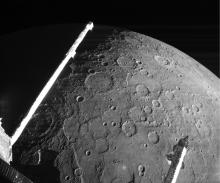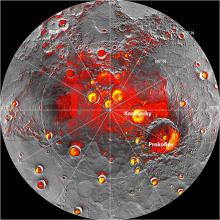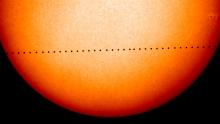Listen to today's episode of StarDate on the web the same day it airs in high-quality streaming audio without any extra ads or announcements. Choose a $8 one-month pass, or listen every day for a year for just $30.
You are here
Moon and Mercury
As twilight begins to paint the dawn sky tomorrow, a couple of planets appear near the crescent Moon. One of them is easily visible from the entire country. The other, though, is best seen from southern latitudes — south of about Oklahoma City or Raleigh, North Carolina.
The easy target is Saturn, the second-largest planet in the solar system. It looks like a golden star to the upper right of the Moon at first light. And the difficult target is Mercury, the smallest planet. As the dawn brightens, it stands below the Moon. It looks like a fairly bright star, but it’s quite low in the sky, so you need a clear horizon to spot it.
Although Mercury is little, it’s also quite dense — the planetary equivalent of a bowling ball. More than half of its volume consists of a core that’s made of iron and nickel.
There are several possible reasons for that. One is that the region where Mercury was born was so hot that most of the lightweight materials near the Sun vaporized and were blown farther into space by the Sun’s radiation. That left mainly the heavier materials to make up the little planet.
Another is that Mercury had more of the lightweight materials when it was born, but they there were blasted into space by a collision with another planet-sized body. That left mainly the dense, heavy core.
Whatever the reason, Mercury is a heavy little bowling ball of a planet rolling around the Sun.
Tomorrow: the influence of a “shocking” star.
Script by Damond Benningfield






